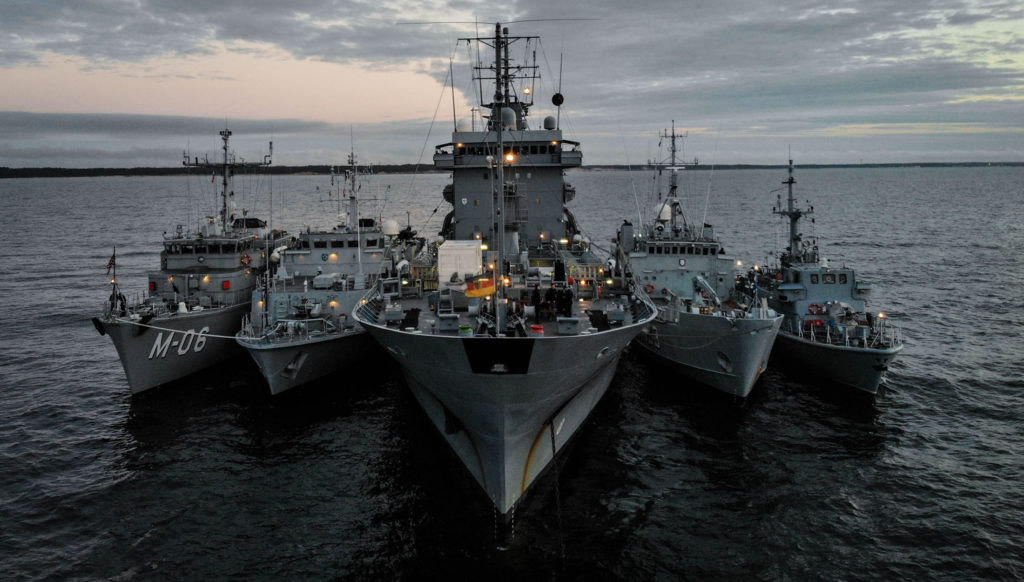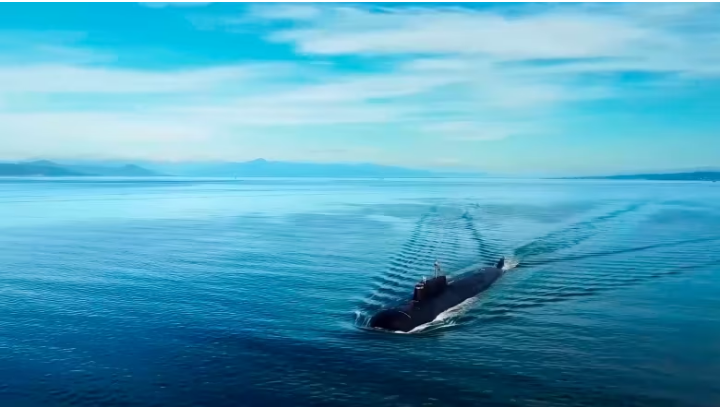
A Russian nuclear submarine sails off to take part in Pacific Fleet drills near Vladivostok, Russia on April 14, 2023. (Russian Defense Ministry Press Service via AP)
Since midnight Wednesday, Moscow time, Russia has been warning the world that any ship approaching a Ukrainian port “will be regarded as potential carriers of military cargo.”
This obvious threat to sink commercial shipping appears to be an attempt to prevent ships from taking on Ukrainian grain. This week, Russia unilaterally ended talks on renewing the Black Sea Grain Initiative that has allowed food to flow to other countries from Ukraine, despite the war.
Ukrainian President Volodymyr Zelenskyy has asked Turkey to join him in a new arrangement to protect grain ships without Russia’s involvement. Turkey has yet to respond.
The threat to sink commercial shipping marks an escalation that can only be carried out under a state of declared war, said Tanya Grodzinski, a naval historian at the Royal Military College in Kingston, Ont. That’s something Russian President Vladimir Putin has been anxious to avoid, opting instead to present his war on Ukraine as a “special military operation.”
The new threat may say more about Russia’s weakness than its strength, as the strategic balance in the waters around European Russia shifts against it.
The day the NATO summit in Vilnius opened — July 11 — was marked in Cuba by the arrival of the Russian Navy warship Perekop of the Baltic Fleet.
The Cuban government welcomed the Perekop — the biggest Russian warship to visit Cuba in many years — with a cannon salute from Havana’s old fort.
For Moscow, the visit allowed Russia to project its military power into the Americas and show support for the Cuban Communist Party, a close ally, on the second anniversary of a popular revolt against its rule.
But as the fanfare unfolded in Havana, events in Vilnius that morning and the night before were building a new fence around the Perekop’s home ports of St Petersburg and Kaliningrad. Russia’s Baltic fleet will still be able to sail in peacetime but it’s being strategically bottled up as its home sea becomes a NATO lake.
And to the south, Russia’s storied Black Sea fleet, already hurt by the humiliating loss of its flagship Moskva, faces an uncertain future and the possible loss of both its bases and its naval supremacy.
One way in, one way out
The Baltic and the Black Sea share a geographical feature: they both have only one slender opening into the world’s oceans.
In the Baltic, three narrow straits separate Denmark from Sweden; the widest, between two Danish islands, is a mere 16 kilometres across.
Ships seeking to exit the Black Sea to enter the Mediterranean must sail the Bosphorus River and the Dardanelles Strait — both of which are entirely within the territorial waters of NATO member Turkey.
Four days after Russia’s full-scale invasion of Ukraine, Turkey closed the straits to all warships, a move that principally affects Russia.
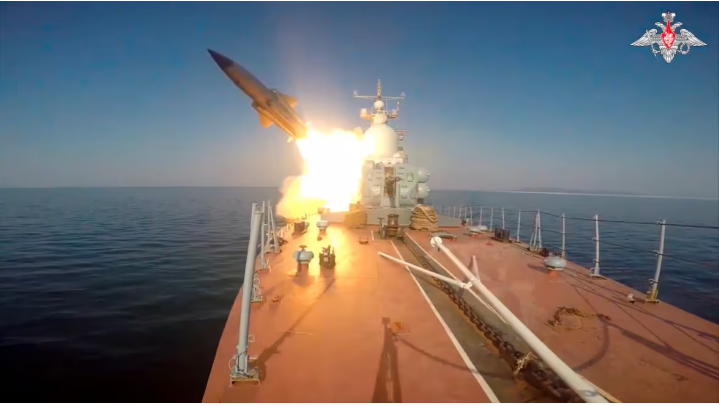
A Russian navy vessel launches an anti-ship missile test in the Peter The Great Gulf in the Sea of Japan on March 28, 2023. (Russian Defense Ministry Press Service via AP)
For those reasons, Russia has long preferred to station the main part of its blue water navy and its nuclear submarines at its Arctic and Pacific ports.
Grodzinski said the Baltic and Black Sea fleets were central to Russia’s emergence as a great power after the 1790s. Russia’s invasion of Ukraine, and NATO’s response to it, threatens that standing, she added.
“If this was viewed as a gamble on the part of Mr. Putin to recreate this image he has of Russia, this historic image of Russian being a great power, it’s being thwarted diplomatically in the Baltic and militarily in Ukraine and the Black Sea,” she told CBC News.
“The implications for his leadership and position could be quite significant.”
Putin and his defenders have claimed he launched his war to keep NATO away from Russia’s borders. Instead, the conflict triggered a new round of NATO expansion that this year caused Russia’s border with the alliance to more than double in length. The accession of Finland in April added more than 1,300 kilometres of NATO-Russia border.
The green light for Sweden to join the alliance, which came on the eve of the Vilnius summit, turns the Baltic Sea into NATO’s backyard.
At the start of the year, the northern shores of the Baltic, including both sides of the Gulf of Bothnia, were neutral territory. Sweden and Finland, two countries that maintain highly professional navies and air forces, had for decades remained outside of the European alliance.
Now, every inch of Baltic shoreline outside of Russian waters is controlled by NATO allies — allies that are increasingly well-armed.
“You’re seeing this rejuvenation of naval forces all across Europe,” said Grodzinski. “Sweden, Norway, Finland and so forth are expanding their navies. There is a greater NATO presence in in the Baltic Sea, which never really occurred before. So there’s a completely different dynamic.”
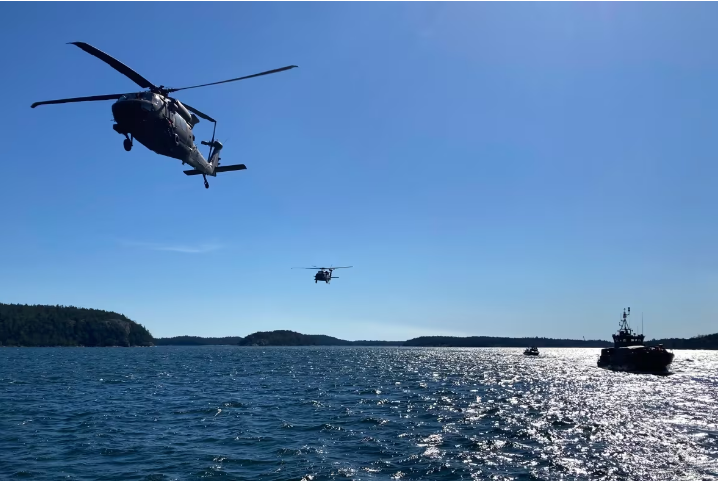
Swedish Black Hawk helicopters fly past the Navy ship that U.S. Defense Secretary Lloyd Austin travels on during a military demonstration through the islands in the southern Stockholm archipelago on Wednesday, April 19, 2023. (Lolita Baldor/Associated Press)
The Swedes, said retired Canadian admiral Mark Norman, “have an incredibly capable military with some very advanced technologies, many of which are homegrown or organic capabilities. They are experts in what I would call sea control in relatively shallow waters.
“They’re experts in mining, counter-mining. They are experts in submarining and in anti-submarining. These are vital capabilities.”
A Russian ship leaving Saint Petersburg must first sail through the Gulf of Finland, where only about 80 kilometres of open water separate Helsinki from the Estonian capital Tallinn. NATO is now on both sides of that narrow strait. The even narrower corridor of international waters in the middle is within easy range of NATO’s sea-skimming missiles from either shore.
The new political geography of the region means “in effect, in any form of conflict, the Baltic gets cut off,” said maritime and arctic security expert Rob Huebert of the University of Calgary.
“We’re not going to be able to see any real movement from the Russians in any capacity because the forces that the Nordic countries, combined with the Americans, bring into the region now mean that point of departure simply will not exist for the Russians.
“The Russian ability to move any naval assets now is increasingly being limited to off the Kola Peninsula as a result of both what’s happening with the Black Sea and what is happening with the Baltic Sea.”
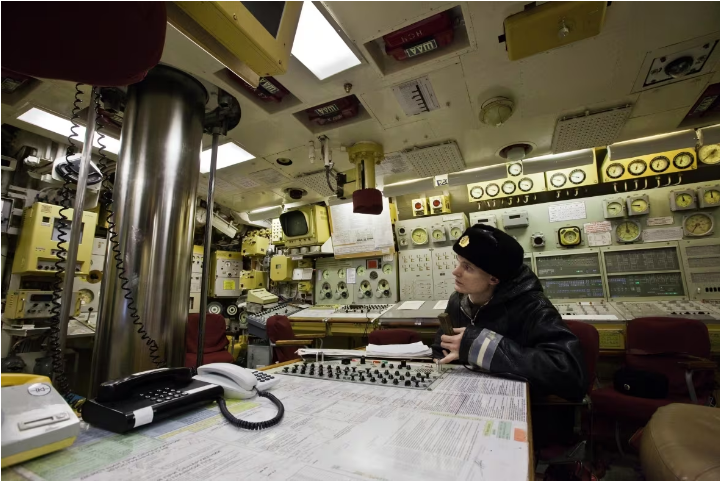
A Russian navy sailor sits at a control room of the Yekaterinburg nuclear submarine in Gadzhiyevo in the Murmansk region on Dec. 9, 2010. (Roustem Adagamov/The Associated Press)
Huebert was referring to Russia’s Arctic bases, such as Murmansk, where it bases nuclear submarines and much of its strategic nuclear missile force.
During the Second World War, with the Baltic in German hands, Murmansk and the White Sea port Archangel were the destinations for convoys that delivered four million tonnes of western lend-lease material to help the Soviet war effort.
The difficult local sea and ice conditions were notorious then and remain a challenge today, said Huebert.
“Climate change of course is opening it up, but it’s still a limited amount of openness at this point in time,” he said. “You still need to have icebreakers to get through. And we see this every year, when the Russians are trying to encourage more shipping through the northern sea route and we’re still seeing ships getting stuck.”
Russia’s other major fleet is based at Vladivostok in the Pacific. Like the Kola Peninsula, Vladivostok is a long way from some of the areas where Russia wants to project power, and also a long way from Russia’s own centres of population.
Russia’s Baltic problem is the result of a change of heart in NATO member Turkey that also affects the Black Sea, where Turkey controls the lion’s share of the coast.
Turkey’s navy has also been going through a major upgrade, while Russia’s Black Sea fleet has suffered losses during the war with Ukraine — including the embarrassing loss of the Moskva, sunk by a Ukrainian missile.
“Whatever the price of Turkey for allowing Sweden to come in, we suspect that they will probably be playing a more active role in NATO,” said Huebert.
Even after the invasion of Ukraine, he said, Ankara seemed to be looking for ways to draw closer to Russia. No longer.
“The suspicion is that some type of agreement was reached, with the terms not publicly released,” said Huebert.
Turkey could have received assurances on its eventual EU membership, for example, or its desire to purchase F-16 fighter jets from the U.S., or other issues that have plagued its relations with Western allies.
“We may never know exactly what’s changed Erdogan’s mind here,” said Norman, “but Turkey has had a change of heart and that is good for NATO.”
The other major threat to Russia’s Black Sea fleet is, of course, Ukraine.
Ever since its founding by Prince Potemkin in 1783, the Black Sea fleet’s home port has been Sevastopol in Crimea. Ukraine allowed Russia to continue to operate its bases there after the breakup of the Soviet Union. In 2014, Russia annexed the peninsula anyway.
The recapture of Crimea is now a Ukrainian war goal. But until very recently, Sevastopol had been mostly out of range of Ukrainian weapons.
That has changed as the front has crept south and new weapons have arrived from Ukraine’s allies.
Ukraine’s acquisition of British Storm Shadow and French SCALP missiles (essentially the same weapon) brings the entire Crimean peninsula within range. The U.S. is currently considering providing ATACMS ballistic missiles, which have an even longer range.
“It severely hampers [the Russians’] freedom of manoeuvre,” said Norman.
It also makes the port of Sevastopol fundamentally unsafe for Russian warships.
“That has enormous operational implications,” Norman said. “It’s a well-established doctrine in naval affairs that the best place to take out any naval asset is alongside, before it goes to sea.
“The safest place for them to be is not to be in port. It’s harder to hit a moving target.”

